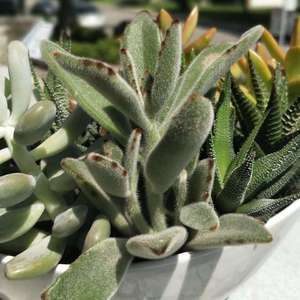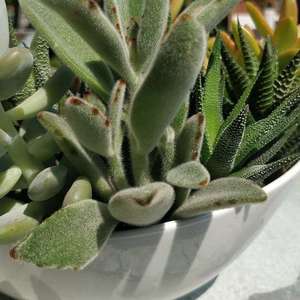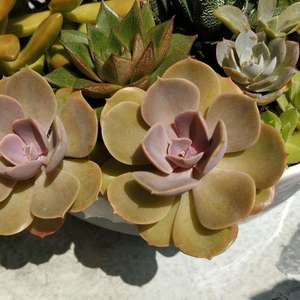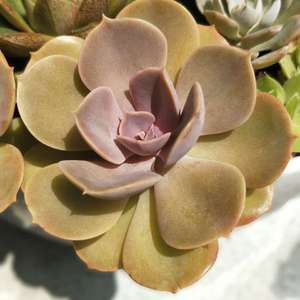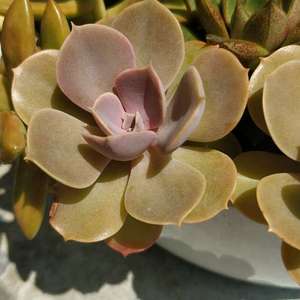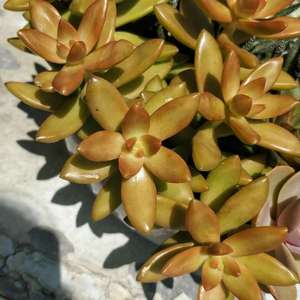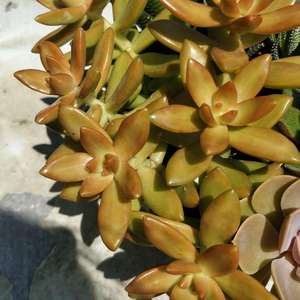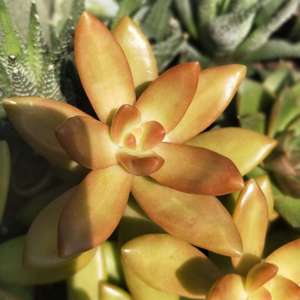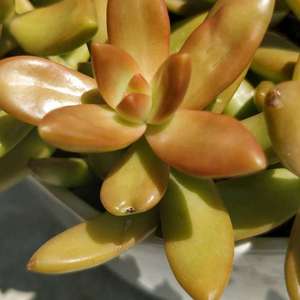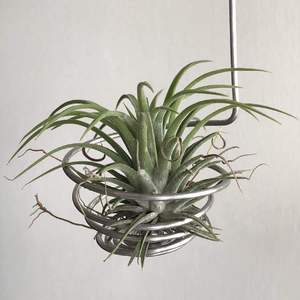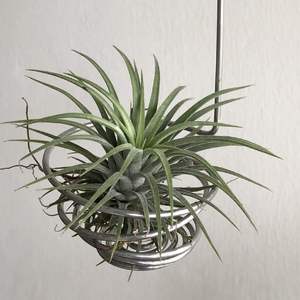成长记
shirly mei
2018年08月09日

Update 2. I've done some research and I think it's called a moonstone?
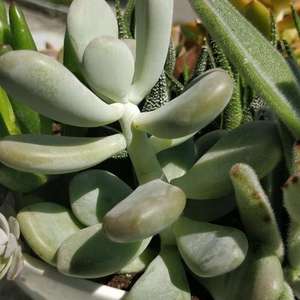
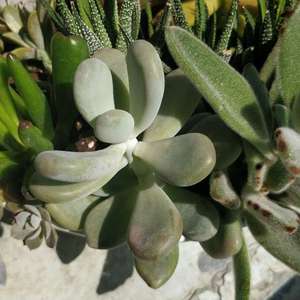
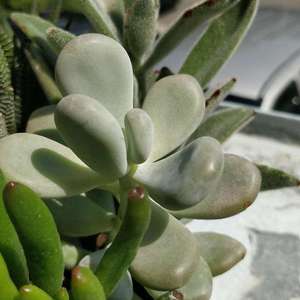



0
0
文章
Miss Chen
2018年08月09日

Description: This plant is a perennial in areas with mild winters, otherwise it is an annual. It is about 2-4' tall and branches frequently. The smooth stems are greyish green and finely pubescent (canescent). The alternate leaves are up to 6" long and 4" across. They are ovate or cordate-ovate, smooth or slightly undulate along the margins, and finely pubescent on the underside (young leaves are finely pubescent on on the upperside as well). Each leaf is usually asymmetric at the base (oblique).
Individual flowers develop on short pedicels where the upper stems branch dichotomously. Each white flower is about 5-7" long and 3-4" across. The corolla has 5 shallow lobes that are barely perceptible; there is a short point between each pair of lobes along the rim of the corolla. Five white stamens are exerted from the center of the corolla. The base of the flower consists of a tubular calyx that has 5 broad teeth along its upper rim; this calyx extends to about ½ the length of the flower, and it lacks conspicuous ridges or wings. The blooming period occurs from mid-summer to fall and lasts about 1-2 months. The flowers often bloom during the day. Each flower is replaced by a prickly seed capsule about 1" across. Each capsule contains several seeds that are large and angular. The root system consists of a taproot. This plant reproduces by reseeding itself.

Cultivation: The preference is full sun, mesic conditions, and fertile loamy soil, preferably at a site that is not too windy. Flea beetles and other insects may chew tiny holes in the leaves.
Range & Habitat: Angel's Trumpet has naturalized in scattered counties across Illinois, although it rarely persists (see Distribution Map). Habitats include areas adjacent to gardens, areas along roads and railroads, and waste areas. This plant is occasionally cultivated in flower gardens, from which it occasionally escapes. Angel's Trumpet was introduced from central America and/or southwestern United States.

Faunal Associations: Little is known about floral-faunal relations for this species. The flowers are pollinated by hummingbirds and Sphinx moths. The foliage contains stramonium (a narcotic) and probably other toxic chemicals, therefore it is unlikely to be bothered by deer and other mammalian herbivores.
Photographic Location: An herb garden at Meadowbrook Park in Urbana, Illinois.

Comments: The flowers are extremely large and showy. The only other member of this genus that has naturalized in Illinois is Datura stramonium (Jimsonweed), which is common and weedy. Like Angel's Trumpet, Jimsonweed is a bushy herbaceous plant with large leaves and funnelform flowers. However, the flowers of Jimsonweed are smaller and less showy (up to 5" long and 2½" across), and they are less likely to bloom during the day. The foliage of Jimsonweed is largely hairless, while Angel's Trumpet has stems and leaf undersides that are finely pubescent. The leaf margins of Jimsonweed are lobed or undulate, while the leaf margins of Angel's Trumpet are smooth or slightly undulate. Another scientific name for Angel's Trumpet is Datura inoxia. Another common name for this species is Ghost Flower.
Individual flowers develop on short pedicels where the upper stems branch dichotomously. Each white flower is about 5-7" long and 3-4" across. The corolla has 5 shallow lobes that are barely perceptible; there is a short point between each pair of lobes along the rim of the corolla. Five white stamens are exerted from the center of the corolla. The base of the flower consists of a tubular calyx that has 5 broad teeth along its upper rim; this calyx extends to about ½ the length of the flower, and it lacks conspicuous ridges or wings. The blooming period occurs from mid-summer to fall and lasts about 1-2 months. The flowers often bloom during the day. Each flower is replaced by a prickly seed capsule about 1" across. Each capsule contains several seeds that are large and angular. The root system consists of a taproot. This plant reproduces by reseeding itself.

Cultivation: The preference is full sun, mesic conditions, and fertile loamy soil, preferably at a site that is not too windy. Flea beetles and other insects may chew tiny holes in the leaves.
Range & Habitat: Angel's Trumpet has naturalized in scattered counties across Illinois, although it rarely persists (see Distribution Map). Habitats include areas adjacent to gardens, areas along roads and railroads, and waste areas. This plant is occasionally cultivated in flower gardens, from which it occasionally escapes. Angel's Trumpet was introduced from central America and/or southwestern United States.

Faunal Associations: Little is known about floral-faunal relations for this species. The flowers are pollinated by hummingbirds and Sphinx moths. The foliage contains stramonium (a narcotic) and probably other toxic chemicals, therefore it is unlikely to be bothered by deer and other mammalian herbivores.
Photographic Location: An herb garden at Meadowbrook Park in Urbana, Illinois.

Comments: The flowers are extremely large and showy. The only other member of this genus that has naturalized in Illinois is Datura stramonium (Jimsonweed), which is common and weedy. Like Angel's Trumpet, Jimsonweed is a bushy herbaceous plant with large leaves and funnelform flowers. However, the flowers of Jimsonweed are smaller and less showy (up to 5" long and 2½" across), and they are less likely to bloom during the day. The foliage of Jimsonweed is largely hairless, while Angel's Trumpet has stems and leaf undersides that are finely pubescent. The leaf margins of Jimsonweed are lobed or undulate, while the leaf margins of Angel's Trumpet are smooth or slightly undulate. Another scientific name for Angel's Trumpet is Datura inoxia. Another common name for this species is Ghost Flower.
0
0
文章
Miss Chen
2018年08月09日

Description: This plant is a summer annual about 2-6' tall that is unbranched below, but branched above, with erect to ascending stems. The stems are light green to dark red, terete, and either glabrous or sparsely short-pubescent. Pairs of opposite compound leaves are widely spaced along the stems. Individual compound leaves are up to 5" long and 3½" across; they are usually bipinnate with narrowly linear lobes (about 1 mm. across) that are light to medium green and glabrous. The compound leaves are either sessile or they have short petioles up to ¼" long.
The upper stems terminate in individual flowerheads about 2-3" across that are on long naked peduncles (4-8" long). The peduncles have characteristics that are similar to the stems. Each flowerhead consists of about 8 ray florets that surround numerous tiny disk florets. The ray florets are sterile, while the disk florets are perfect and fertile. The petaloid extensions of the ray florets are white, pink, or magenta; sometimes they are bicolored. In addition, these petaloid extensions are obovate in shape and their outer edges are shallowly cleft. The circular perimeter of the disk florets spans about ½" across; it is relatively small in relation to the diameter of the flowerhead. Individual disk florets are about ¼" long, bright yellow, and narrowly cylindrical. At the base of the flowerhead, there are floral bracts (phyllaries) in 2 series; there are about 8 floral bractsDistribution Map in each series. The outer floral bracts are green and lanceolate, while the inner floral bracts are purple and ovate. Both types of bracts are about ½" in length. Together, the floral bracts form a shallow cup at the base of the flowerhead. The blooming period occurs from mid-summer into the fall, lasting 2-3 months. Afterwards, the disk florets of each flowerhead are replaced by narrowly cylindrical-angular achenes about ½" long. Each slightly curved achene is slightly swollen toward its outer tip, where there is a minute beak. A pair of awns about 1 mm. in length is sometimes present at this beak. The outer surface of each mature achene is dark-colored. The root system consists of a taproot. This plants reproduces by reseeding itself.
Cultivation: The preference is full sun, mesic or dry-mesic conditions, and a mildly acidic to alkaline soil containing loam, clay loam, gravel, or sand. Once the seeds germinate, growth and development is rapid. Wild plants tend to be shorter and bloom less abundantly than garden plants in fertile soil, otherwise they appear much the same.
Range & Habitat: The introduced Common Cosmos rarely naturalizes in Illinois, where it has been reported in only a few counties. Wild populations of this plant rarely persist. Common Cosmos was introduced into the United States as an ornamental flowering plant from Mexico or tropical America, and it is still commonly cultivated. Habitats include fallow or abandoned fields, roadsides, areas along railroads, and waste areas. Habitats with a history of disturbance and relatively open ground are preferred.
Faunal Associations: Very little is known about the floral-faunal relationships for this introduced plant in North America. Butterflies and possibly other insects visit the flowers for nectar and/or pollen. Insects that feed destructively on Cosmos spp. include Macrosteles fascifrons (Aster Leafhopper) and the polyphagous caterpillars of Rachiplusia ou (Gray Looper Moth).
Photographic Location: A fallow field near Champaign, Illinois.
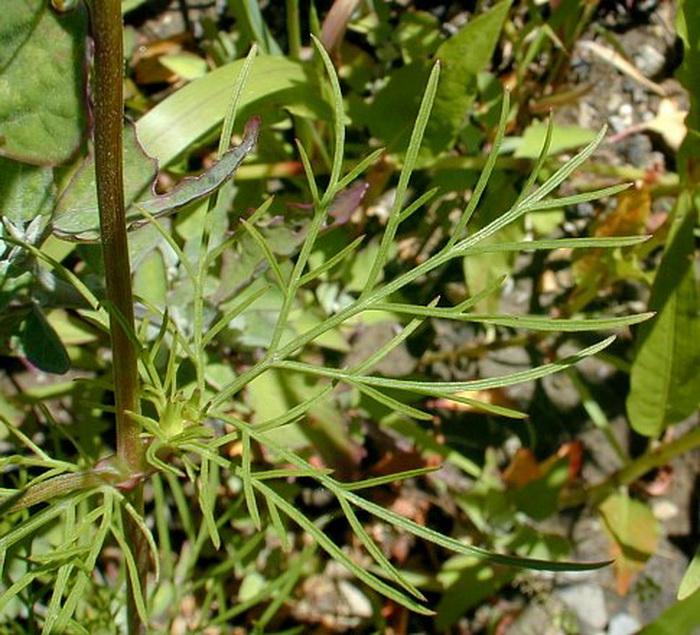
Comments: Because of its attractive flowers, fine fern-like foliage, and ease of cultivation, it is easy to understand why Common Cosmos remains a popular garden plant. There are many cultivars to choose from. While Common Cosmos occasionally reseeds itself, it has not been invasive in Illinois. It is easy to identify in the wild because nothing else closely resembles it, except other non-native Cosmos spp., that so far have not escaped from cultivation within the state. Some Coreopsis spp. have finely divided foliage and similar flowerheads, but they tend to be shorter plants and their flowerheads are usually yellow.
The upper stems terminate in individual flowerheads about 2-3" across that are on long naked peduncles (4-8" long). The peduncles have characteristics that are similar to the stems. Each flowerhead consists of about 8 ray florets that surround numerous tiny disk florets. The ray florets are sterile, while the disk florets are perfect and fertile. The petaloid extensions of the ray florets are white, pink, or magenta; sometimes they are bicolored. In addition, these petaloid extensions are obovate in shape and their outer edges are shallowly cleft. The circular perimeter of the disk florets spans about ½" across; it is relatively small in relation to the diameter of the flowerhead. Individual disk florets are about ¼" long, bright yellow, and narrowly cylindrical. At the base of the flowerhead, there are floral bracts (phyllaries) in 2 series; there are about 8 floral bractsDistribution Map in each series. The outer floral bracts are green and lanceolate, while the inner floral bracts are purple and ovate. Both types of bracts are about ½" in length. Together, the floral bracts form a shallow cup at the base of the flowerhead. The blooming period occurs from mid-summer into the fall, lasting 2-3 months. Afterwards, the disk florets of each flowerhead are replaced by narrowly cylindrical-angular achenes about ½" long. Each slightly curved achene is slightly swollen toward its outer tip, where there is a minute beak. A pair of awns about 1 mm. in length is sometimes present at this beak. The outer surface of each mature achene is dark-colored. The root system consists of a taproot. This plants reproduces by reseeding itself.
Cultivation: The preference is full sun, mesic or dry-mesic conditions, and a mildly acidic to alkaline soil containing loam, clay loam, gravel, or sand. Once the seeds germinate, growth and development is rapid. Wild plants tend to be shorter and bloom less abundantly than garden plants in fertile soil, otherwise they appear much the same.
Range & Habitat: The introduced Common Cosmos rarely naturalizes in Illinois, where it has been reported in only a few counties. Wild populations of this plant rarely persist. Common Cosmos was introduced into the United States as an ornamental flowering plant from Mexico or tropical America, and it is still commonly cultivated. Habitats include fallow or abandoned fields, roadsides, areas along railroads, and waste areas. Habitats with a history of disturbance and relatively open ground are preferred.
Faunal Associations: Very little is known about the floral-faunal relationships for this introduced plant in North America. Butterflies and possibly other insects visit the flowers for nectar and/or pollen. Insects that feed destructively on Cosmos spp. include Macrosteles fascifrons (Aster Leafhopper) and the polyphagous caterpillars of Rachiplusia ou (Gray Looper Moth).
Photographic Location: A fallow field near Champaign, Illinois.

Comments: Because of its attractive flowers, fine fern-like foliage, and ease of cultivation, it is easy to understand why Common Cosmos remains a popular garden plant. There are many cultivars to choose from. While Common Cosmos occasionally reseeds itself, it has not been invasive in Illinois. It is easy to identify in the wild because nothing else closely resembles it, except other non-native Cosmos spp., that so far have not escaped from cultivation within the state. Some Coreopsis spp. have finely divided foliage and similar flowerheads, but they tend to be shorter plants and their flowerheads are usually yellow.
0
0
文章
Miss Chen
2018年08月06日

Description: This perennial plant is a herbaceous vine that produces stems 2-4' long. The stems are usually glabrous, but are sometimes hairy where new growth occurs. The alternate leaves are 1-2' long and half as much across. They are often sagittate (arrowhead-shaped), but are variable and can assume other forms as well. Their margins are smooth and occasionally slightly ciliate. Long slender petioles connect the leaves with the stems. A slender flowering stalk may develop from the base of a petiole. This stalk occasionally branches and can produce 1-3 flowers. The corolla of a flower is funnelform in shape and up to 1" across; it is usually white, sometimes with light pink patterns. The 5 lobes of the corolla are very shallow and barely perceptible. Toward the throat of the corolla is a patch of yellow and the reproductive parts, consisting of 5 stamens and a pistil with a divided style. These reproductive parts are usually white, although the anthers may be pink or light purple in flowers with pink corollas. At the base of the flower, there are 5 green sepals that are much smaller than the corolla. Up to 1" below the base of a flower, there are a pair of small green bracts on the flowering stalk.
The blooming period can occur from late spring to early fall, and can span several months, even though individual flowers persist for only a single day, usually opening during the morning and closing by late afternoon. A hairless and well-rounded seed capsule about ¼" long replaces each flower; each 2-celled capsule contains 4 seeds. These dark seeds are 3-angled and oblong, but tapering somewhat at the ends. Each seed usually has 2 flat sides and 1 convex side; it is about 1/8" long. The root system consists of a slender taproot that branches frequently; it can extend 20' into the ground. Rhizomes are also produced in abundance, so that this plant often forms vegetative colonies.
Cultivation: Field Bindweed prefers full sunlight and mesic to dry conditions. It has considerable drought tolerance, and flourishes in poor soil that contains sand, gravel, or hardpan clay. It will also grow in moist fertile soil, but dislikes competition from taller plants. Eradication of this plant is difficult, as mechanical cultivation often spreads the rhizomes around, producing new plants. Because of the deep root system, it has been known to survive bulldozer operations. It can also persist in lawns, notwithstanding regular lawn-mowing. The application of broadleaf herbicides can be an effective control measure, if it is repeated as needed.

Range & Habitat: Field Bindweed is a common plant that has been reported from most counties in Illinois (see Distribution Map); it is native to Eurasia. This plant continues to spread and probably occurs in every county of the state. Habitats include lawns, gardens, fields, clay banks, areas along roadsides and railroads (including ballast), vacant lots, and miscellaneous waste areas. This plant occurs primarily in disturbed areas.
Faunal Associations: Mostly long-tongued bees visit the flowers for nectar, including bumblebees and little carpenter bees (Ceratina spp.). In addition, specialist bees that are attracted to funnelform flowers also visit the flowers for nectar, including Melitoma taurea (Mallow Bee) and Cemolobus ipomoeae (Morning Glory Bee). The adults and larvae of several tortoise beetles are known to feed destructively on the foliage of Field Bindweed, including Charidotella sexpunctata (Golden Tortoise Beetle), Chelymorpha cassidea (Argus Tortoise Beetle), Deloyala guttata (Mottled Tortoise Beetle), and Jonthonota nigripes (Black-legged Tortoise Beetle). Other beetles that feed on this plant include Chaetocnema confinis (Sweet Potato Flea Beetle) and Typophorus nigritus (Sweet Potato Leaf Beetle); see Clark et al. (2004). The larvae of a sawfly, Sphacophilus cellularis, feed on the leaves of bindweeds (Convolvulus spp.), as do the larvae of several moths, including Bedellia somnulentella (Morning Glory Leafminer), Spragueia leo (Common Spragueia), Emmelina monodactyla (Morning Glory Plume Moth), and Agrius cingulatus (Pink-spotted Hawk Moth); see Smith (2006), Cranshaw (2004), Covell (1984/2005), and Wagner (2005). Field Bindweed is not a preferred food source for mammalian herbivores because the foliage is mildly toxic. Furthermore, there have been reports of the rootstocks poisoning swine.
Photographic Location: Along a railroad in Urbana, Illinois. This plant is very common in the area.
Comments: Field Bindweed is an attractive plant while it is in flower, but it can be very aggressive and persistent. The flowers are smaller in size than Calystegia sepium (Hedge Bindweed) and Ipomoea pandurata (Wild Sweet Potato). Its leaves are sagittate, while the leaves of Ipomoea pandurata (Wild Sweet Potato) and Ipomoea lacunosa (Small White Morning Glory) are cordate.
The blooming period can occur from late spring to early fall, and can span several months, even though individual flowers persist for only a single day, usually opening during the morning and closing by late afternoon. A hairless and well-rounded seed capsule about ¼" long replaces each flower; each 2-celled capsule contains 4 seeds. These dark seeds are 3-angled and oblong, but tapering somewhat at the ends. Each seed usually has 2 flat sides and 1 convex side; it is about 1/8" long. The root system consists of a slender taproot that branches frequently; it can extend 20' into the ground. Rhizomes are also produced in abundance, so that this plant often forms vegetative colonies.
Cultivation: Field Bindweed prefers full sunlight and mesic to dry conditions. It has considerable drought tolerance, and flourishes in poor soil that contains sand, gravel, or hardpan clay. It will also grow in moist fertile soil, but dislikes competition from taller plants. Eradication of this plant is difficult, as mechanical cultivation often spreads the rhizomes around, producing new plants. Because of the deep root system, it has been known to survive bulldozer operations. It can also persist in lawns, notwithstanding regular lawn-mowing. The application of broadleaf herbicides can be an effective control measure, if it is repeated as needed.

Range & Habitat: Field Bindweed is a common plant that has been reported from most counties in Illinois (see Distribution Map); it is native to Eurasia. This plant continues to spread and probably occurs in every county of the state. Habitats include lawns, gardens, fields, clay banks, areas along roadsides and railroads (including ballast), vacant lots, and miscellaneous waste areas. This plant occurs primarily in disturbed areas.
Faunal Associations: Mostly long-tongued bees visit the flowers for nectar, including bumblebees and little carpenter bees (Ceratina spp.). In addition, specialist bees that are attracted to funnelform flowers also visit the flowers for nectar, including Melitoma taurea (Mallow Bee) and Cemolobus ipomoeae (Morning Glory Bee). The adults and larvae of several tortoise beetles are known to feed destructively on the foliage of Field Bindweed, including Charidotella sexpunctata (Golden Tortoise Beetle), Chelymorpha cassidea (Argus Tortoise Beetle), Deloyala guttata (Mottled Tortoise Beetle), and Jonthonota nigripes (Black-legged Tortoise Beetle). Other beetles that feed on this plant include Chaetocnema confinis (Sweet Potato Flea Beetle) and Typophorus nigritus (Sweet Potato Leaf Beetle); see Clark et al. (2004). The larvae of a sawfly, Sphacophilus cellularis, feed on the leaves of bindweeds (Convolvulus spp.), as do the larvae of several moths, including Bedellia somnulentella (Morning Glory Leafminer), Spragueia leo (Common Spragueia), Emmelina monodactyla (Morning Glory Plume Moth), and Agrius cingulatus (Pink-spotted Hawk Moth); see Smith (2006), Cranshaw (2004), Covell (1984/2005), and Wagner (2005). Field Bindweed is not a preferred food source for mammalian herbivores because the foliage is mildly toxic. Furthermore, there have been reports of the rootstocks poisoning swine.
Photographic Location: Along a railroad in Urbana, Illinois. This plant is very common in the area.
Comments: Field Bindweed is an attractive plant while it is in flower, but it can be very aggressive and persistent. The flowers are smaller in size than Calystegia sepium (Hedge Bindweed) and Ipomoea pandurata (Wild Sweet Potato). Its leaves are sagittate, while the leaves of Ipomoea pandurata (Wild Sweet Potato) and Ipomoea lacunosa (Small White Morning Glory) are cordate.
0
0
文章
Miss Chen
2018年08月06日

Raceme of FlowersDescription: This annual plant is about 2-3' tall. It often produces 2 or 3 forking stems that are themselves little branched. These stems are round and pubescent, although with age they often become glabrous. The alternate leaves are sessile, palmately divided, and up to 3" long and across. Their lobes repeatedly subdivide into smaller lobes that are narrowly linear, providing the leaves with a lacy appearance. They are slightly pubescent and often have a silky appearance. The stems terminate into spike-like racemes of blue-violet flowers. These racemes can be up to 1' in length. Each flower is about 2" across, consisting of 5 petal-like sepals, 4 petals, a single pistil, and some stamens with light blue anthers. The upper sepal forms a hood in front and an upward-curving spur in back about 1" long. The middle and lower sepals are well-rounded and spreading. The 2 upper petals form a protective inner hood of the reproductive organs; they are not fused together. The 2 lower petals form a V-shaped landing pad for visiting insects. The outer sepals are larger in size than the inner petals. At the base of each flower is a slender pedicel about 1" long. The blooming period occurs during the summer and lasts about 1-2 months. Each flower is replaced by a pubescent follicle containing numerous small black seeds. These seeds are small enough to be dispersed by gusts of wind. The root system is a slender branching taproot. This plant spreads by reseeding itself, and may form colonies at favorable sites, although it usually doesn't persist.
Cultivation: The preference is full sunlight, moist to mesic conditions, and a loamy fertile soil. This plant develops quickly, shooting up like a rocket, hence the common name. However, in poor soil and droughty conditions, growth will be stunted.
Range & Habitat: Rocket Larkspur is an occasional plant that has been reported from scattered counties in Illinois, except in the NW area of the state (see Distribution Map). Habitats consist of areas along railroads and roadsides, banks of drainage ditches, abandoned fields, vacant lots, and flower gardens. There is a strong preference for disturbed areas; it does not appear to invade higher quality natural habitats to any significant extent, at least in Illinois. Rocket Larkspur originated from the Mediterranean area of Europe; it was introduced into the United States as an ornamental plant.
Faunal Associations: Long-tongued bees pollinate the flowers, especially bumblebees. Butterflies may visit the flowers occasionally, but they are unlikely to be effective at pollination. The larvae of a fly, Phytomyza delphinivora, mine the leaves of Consolida spp. (larkspurs), and the caterpillars of a polyphagous moth, Megalographa biloba (Bilobed Looper Moth), also feed on the foliage (Cranshaw, 2004; Wagner, 2005). Because of the presence of an alkaloid, delphinine, both the foliage and small seeds are quite toxic. Therefore, they are of little value as a food source to birds and mammals. Like the closely related Delphinium spp. (delphiniums), the larkspurs occasionally poison livestock.
Photographic Location: The lower bank of a large drainage ditch in Urbana, Illinois.

Comments: Rocket Larkspur produces attractive flowers on long spike-like racemes, therefore it is not surprising that this species is grown in flower gardens, from which it occasionally escapes. Unlike the Delphiniums, which are perennial plants, the Consolida spp. (Larkspurs) are annual plants. While the flower of a Delphinium has 3 pistils, the flower of a Larkspur has only a single pistil. The only other Larkspur that escapes into the wild in Illinois is Consolida regalis (Forking Larkspur). This is another introduced plant from the Mediterranean area of Europe that is less commonly encountered than Rocket Larkspur. Its flowers are often a lighter shade of blue-violet than Rocket Larkspur, and the upper petals of its flowers are fused together. The follicles (seed capsules) of Forking Larkspur are glabrous, while the follicles of Rocket Larkspur are pubescent.
Cultivation: The preference is full sunlight, moist to mesic conditions, and a loamy fertile soil. This plant develops quickly, shooting up like a rocket, hence the common name. However, in poor soil and droughty conditions, growth will be stunted.
Range & Habitat: Rocket Larkspur is an occasional plant that has been reported from scattered counties in Illinois, except in the NW area of the state (see Distribution Map). Habitats consist of areas along railroads and roadsides, banks of drainage ditches, abandoned fields, vacant lots, and flower gardens. There is a strong preference for disturbed areas; it does not appear to invade higher quality natural habitats to any significant extent, at least in Illinois. Rocket Larkspur originated from the Mediterranean area of Europe; it was introduced into the United States as an ornamental plant.
Faunal Associations: Long-tongued bees pollinate the flowers, especially bumblebees. Butterflies may visit the flowers occasionally, but they are unlikely to be effective at pollination. The larvae of a fly, Phytomyza delphinivora, mine the leaves of Consolida spp. (larkspurs), and the caterpillars of a polyphagous moth, Megalographa biloba (Bilobed Looper Moth), also feed on the foliage (Cranshaw, 2004; Wagner, 2005). Because of the presence of an alkaloid, delphinine, both the foliage and small seeds are quite toxic. Therefore, they are of little value as a food source to birds and mammals. Like the closely related Delphinium spp. (delphiniums), the larkspurs occasionally poison livestock.
Photographic Location: The lower bank of a large drainage ditch in Urbana, Illinois.

Comments: Rocket Larkspur produces attractive flowers on long spike-like racemes, therefore it is not surprising that this species is grown in flower gardens, from which it occasionally escapes. Unlike the Delphiniums, which are perennial plants, the Consolida spp. (Larkspurs) are annual plants. While the flower of a Delphinium has 3 pistils, the flower of a Larkspur has only a single pistil. The only other Larkspur that escapes into the wild in Illinois is Consolida regalis (Forking Larkspur). This is another introduced plant from the Mediterranean area of Europe that is less commonly encountered than Rocket Larkspur. Its flowers are often a lighter shade of blue-violet than Rocket Larkspur, and the upper petals of its flowers are fused together. The follicles (seed capsules) of Forking Larkspur are glabrous, while the follicles of Rocket Larkspur are pubescent.
0
0
文章
Miss Chen
2018年08月06日

Description: This plant is a summer annual about 1-3' long. It can be erect or sprawl across the ground like a vine. The round stems are smooth and hairless. The hairless alternate leaves are up to 5" long and 2" across. They are ovate, lanceolate-ovate, or slightly cordate. Their margins are smooth and their veins run parallel to each other. The base of each leaf is sessile or clasping, and it has a membranous sheath that wraps around the stem. This sheath is about 1" long and has green longitudinal veins, otherwise it is white or greenish white. The upper edge of the sheath is usually hairless, although it has fine upright hairs for an uncommon variety of this species.
Occasionally, a single flower on a stalk about 1-2" long is produced from the leaf axils. This flower is about ½–1" across, consisting of 2 large blue petals, 1 small white petal, 3 sepals, 5-6 stamens, and a long white style. The sepals are usually pale white and translucent. The upper stamens have showy yellow anthers; they are sterile, but help to attract insects to the flower. The lower stamens are longer than the upper stamens and fertile, although their anthers are less showy. An upturned spathe that lies underneath the flower is green and about 1-2" long. The upper margins of this spathe are free all the way to the base. The blooming period occurs from mid-summer to early fall, and lasts about 1-2 months. Each flower blooms during the morning for a single day, hence the common name. There is no noticeable floral scent. Each flower is replaced by a seed capsule that has 2 cells, each cell containing 2 seeds. These seeds are dark brown or black and have a surface that is bumpy and rough (rugose). The root system is fibrous. This plant can root at the leaf nodes on moist ground, forming new plants vegetatively. At favorable sites, the Asiatic Dayflower forms colonies that can exclude other species of plants.

Cultivation: Partial sun, moist to mesic conditions, and a fertile soil that is loamy or slightly sandy are preferred. This plant also tolerates full sun and light shade. Occasionally, it can spread aggressively and become a pest.
Range & Habitat: The Asiatic Dayflower is a common plant that occurs in most counties of Illinois (see Distribution Map). It appears to be spreading into all areas of the state. Habitats include edges of floodplain forests, thickets, edges of gardens and yards, areas along buildings, fence rows, vacant lots, and waste areas. This plant prefers disturbed areas, although it occasionally invades natural areas. As the common name implies, it was introduced into the United States from East Asia, probably for horticultural purposes.

Faunal Associations: Primarily bees pollinate the flowers. The foliage is eaten by Neolema sexpunctata (Six-Spotted Beetle). Occasionally, the seeds are eaten by upland gamebirds and songbirds, including the Mourning Dove, Bobwhite, and Redwing Blackbird. The foliage of Dayflowers is a preferred food source of the White-Tailed Deer.
Photographic Location: A small colony of Asiatic Dayflower was flourishing between the shrubbery of a commercial bank and a city sidewalk in Urbana, Illinois.

Comments: The flowers of this species have a "true blue" color that is found in few other plants. Usually, most "blue" flowers are closer to violet or purple. The Asiatic Dayflower has become the most common Commelina sp. (Dayflower) in Illinois for reasons that are not entirely clear. Like the native Commelina erecta (Erect Dayflower), its flowers have a small lower petal that is white, whereas the flowers of other Commelina spp. within the state have a lower petal that is blue or violet. The Erect Dayflower differs from the Asiatic Dayflower in a number of characteristics, including the following: 1) It has more narrow leaves than the latter; 2) The upper margins of each upturned spathe are united together about 1/3 the length of the spathe from the base, rather than running free from each other; 3) Each seed capsule has 3 cells containing 1 seed each, rather than 2 cells containing 2 seeds each; 4) It is a more erect plant than the latter; and 5) Its seeds are lighter-colored with a smooth surface, rather than dark and rugose.
Occasionally, a single flower on a stalk about 1-2" long is produced from the leaf axils. This flower is about ½–1" across, consisting of 2 large blue petals, 1 small white petal, 3 sepals, 5-6 stamens, and a long white style. The sepals are usually pale white and translucent. The upper stamens have showy yellow anthers; they are sterile, but help to attract insects to the flower. The lower stamens are longer than the upper stamens and fertile, although their anthers are less showy. An upturned spathe that lies underneath the flower is green and about 1-2" long. The upper margins of this spathe are free all the way to the base. The blooming period occurs from mid-summer to early fall, and lasts about 1-2 months. Each flower blooms during the morning for a single day, hence the common name. There is no noticeable floral scent. Each flower is replaced by a seed capsule that has 2 cells, each cell containing 2 seeds. These seeds are dark brown or black and have a surface that is bumpy and rough (rugose). The root system is fibrous. This plant can root at the leaf nodes on moist ground, forming new plants vegetatively. At favorable sites, the Asiatic Dayflower forms colonies that can exclude other species of plants.

Cultivation: Partial sun, moist to mesic conditions, and a fertile soil that is loamy or slightly sandy are preferred. This plant also tolerates full sun and light shade. Occasionally, it can spread aggressively and become a pest.
Range & Habitat: The Asiatic Dayflower is a common plant that occurs in most counties of Illinois (see Distribution Map). It appears to be spreading into all areas of the state. Habitats include edges of floodplain forests, thickets, edges of gardens and yards, areas along buildings, fence rows, vacant lots, and waste areas. This plant prefers disturbed areas, although it occasionally invades natural areas. As the common name implies, it was introduced into the United States from East Asia, probably for horticultural purposes.

Faunal Associations: Primarily bees pollinate the flowers. The foliage is eaten by Neolema sexpunctata (Six-Spotted Beetle). Occasionally, the seeds are eaten by upland gamebirds and songbirds, including the Mourning Dove, Bobwhite, and Redwing Blackbird. The foliage of Dayflowers is a preferred food source of the White-Tailed Deer.
Photographic Location: A small colony of Asiatic Dayflower was flourishing between the shrubbery of a commercial bank and a city sidewalk in Urbana, Illinois.

Comments: The flowers of this species have a "true blue" color that is found in few other plants. Usually, most "blue" flowers are closer to violet or purple. The Asiatic Dayflower has become the most common Commelina sp. (Dayflower) in Illinois for reasons that are not entirely clear. Like the native Commelina erecta (Erect Dayflower), its flowers have a small lower petal that is white, whereas the flowers of other Commelina spp. within the state have a lower petal that is blue or violet. The Erect Dayflower differs from the Asiatic Dayflower in a number of characteristics, including the following: 1) It has more narrow leaves than the latter; 2) The upper margins of each upturned spathe are united together about 1/3 the length of the spathe from the base, rather than running free from each other; 3) Each seed capsule has 3 cells containing 1 seed each, rather than 2 cells containing 2 seeds each; 4) It is a more erect plant than the latter; and 5) Its seeds are lighter-colored with a smooth surface, rather than dark and rugose.
0
0
绝骨
2018年08月02日

18年8月2日,帝都,爆热。迎来了4位新成员:半球,果冻,冰玉,达摩。总之折腾了1个多小时,种上了。说实在的,这两天买还不如一个月前暴雨时候买,至少那会儿凉快啊!但是手欠啊!就买了哈哈哈。放在没直晒又通风的北窗台,晾着。听天由命。


1
0
文章
Miss Chen
2018年08月01日

Description: This plant is a summer annual about 2-5' tall (in more tropical climates, it is a perennial). More or less erect, Mexican Tea branches occasionally to frequently; Small side branches frequently develop from the axils of the leaves. The stems are terete to slightly angular, hairless, conspicuously veined, and variably colored – often some combination of olive green, dull red, and cream. The alternate leaves are up to 4" long and 1½" across; they are ovate to narrowly ovate, medium green to yellow-green or red-green, and hairless. The bases of these leaves are always wedge-shaped and never rounded. The leaf undersides are never white-mealy. The leaf margins are highly variable, even on the same plant – smooth, undulate, bluntly dentate, or somewhat pinnatifid. The upper leaves are smaller in size than the moderate to lower leaves, and their leaf margins are more smooth. Both the stems and leaves have minute glands that secrete an aromatic oil; they exude a somewhat musky medicinal scent.
The upper stems and smaller side stems terminate in spikes of sessile flowers (up to 1' long) that are interspersed with small leafy bracts. The small greenish flowers are arranged in dense clusters along these spikes. Each flower is a little less than ¼" across, consisting of 5 green sepals, a rather flat pistil with tiny styles, and 5 stamens with large white anthers. The small sepals are ovate in shape and curved inward; they are neither hairy nor white-mealy. The anthers are the most conspicuous part of the flower. The blooming period occurs from mid-summer into the fall and lasts 2-3 months. The bisexual flowers are wind-pollinated, although they can also self-pollinate themselves. Each flower is replaced by a single tiny seed (achene); a thinDistribution Map membrane surrounding the seed is rather loose and easily removed. The seeds are round, flattened, black, and shiny; they are small enough to be blown about by the wind. The root system consists of a taproot.
Cultivation: Mexican Tea prefers full to partial sun and moist to slightly dry conditions. Growth is more robust in fertile loamy soil with abundant nitrogen, but it will adapt to other kinds of soil.
Range & Habitat: The non-native Mexican Tea is occasional in the southern half of Illinois, becoming uncommon or absent in the northern half of the state. It was introduced from tropical America as a medicinal herb. Habitats include fields, roadsides, vacant lots, and waste areas. Mexican Tea is still cultivated in gardens, from where it occasionally escapes and manages to reseed itself. Disturbed habitats of a relatively open character are strongly preferred.
Faunal Associations: Information that is specific to Mexican Tea is lacking (except for grazing mammals), therefore faunal-floral relationships for Chenopodium spp. in general will be presented. I suspect that some insects are deterred by the toxicity of the floral oil, and don't feed on this species to same extent as other Chenopodium spp. The caterpillars of two skippers, Pholisora catullus (Common Sootywing) and Staphylus hayhurstii (Hayhurst's Scallopwing), feed on the leaves of Chenopodium spp. Other insect feeders include moth caterpillars, flea beetles, leaf beetles, plant bugs, and aphids (see the Insect Table for a listing of these species). The tiny seeds are eaten by many small songbirds, particularly sparrows (see the Bird Table); some upland gamebirds (e.g., Bobwhite, Hungarian Partridge, & Ring-Necked Pheasant) also eat the seeds or seedheads. Small rodents eat the seeds, including the Thirteen-Lined Ground Squirrel, White-Footed Mouse, and Prairie Deer Mouse. Because the foliage is toxic and probably distasteful, it is not eaten by grazing mammals; even goats refuse to eat this plant (see Georgia, 1913).
Photographic Location: A garden in downtown Champaign, Illinois.

Comments: Because of its anthelmintic properties, Mexican Tea has been used to remove intestinal worms. This is one of the reasons it is cultivated as a medicinal herb. This plant can be distinguished from other Chenopodium spp. by the shape of its leaves, the absence of white-mealiness on its leaf undersides and sepals, and the strong aroma of its foliage. Its lower to middle leaves have wedge-shaped bottoms, while the leaf bottoms of similar Chenopodium spp. are usually well-rounded. Sometimes the margins of these leaves are more wavy or pinnatifid than those of other species. This combination of factors makes Mexican Tea one of the easier Chenopodium spp. to identify. A variety of Mexican Tea that is without leafy bracts in its floral spikes has been referred to as Chenopodium ambrosioides anthelminticum. It is less common than the typical variety.
The upper stems and smaller side stems terminate in spikes of sessile flowers (up to 1' long) that are interspersed with small leafy bracts. The small greenish flowers are arranged in dense clusters along these spikes. Each flower is a little less than ¼" across, consisting of 5 green sepals, a rather flat pistil with tiny styles, and 5 stamens with large white anthers. The small sepals are ovate in shape and curved inward; they are neither hairy nor white-mealy. The anthers are the most conspicuous part of the flower. The blooming period occurs from mid-summer into the fall and lasts 2-3 months. The bisexual flowers are wind-pollinated, although they can also self-pollinate themselves. Each flower is replaced by a single tiny seed (achene); a thinDistribution Map membrane surrounding the seed is rather loose and easily removed. The seeds are round, flattened, black, and shiny; they are small enough to be blown about by the wind. The root system consists of a taproot.
Cultivation: Mexican Tea prefers full to partial sun and moist to slightly dry conditions. Growth is more robust in fertile loamy soil with abundant nitrogen, but it will adapt to other kinds of soil.
Range & Habitat: The non-native Mexican Tea is occasional in the southern half of Illinois, becoming uncommon or absent in the northern half of the state. It was introduced from tropical America as a medicinal herb. Habitats include fields, roadsides, vacant lots, and waste areas. Mexican Tea is still cultivated in gardens, from where it occasionally escapes and manages to reseed itself. Disturbed habitats of a relatively open character are strongly preferred.
Faunal Associations: Information that is specific to Mexican Tea is lacking (except for grazing mammals), therefore faunal-floral relationships for Chenopodium spp. in general will be presented. I suspect that some insects are deterred by the toxicity of the floral oil, and don't feed on this species to same extent as other Chenopodium spp. The caterpillars of two skippers, Pholisora catullus (Common Sootywing) and Staphylus hayhurstii (Hayhurst's Scallopwing), feed on the leaves of Chenopodium spp. Other insect feeders include moth caterpillars, flea beetles, leaf beetles, plant bugs, and aphids (see the Insect Table for a listing of these species). The tiny seeds are eaten by many small songbirds, particularly sparrows (see the Bird Table); some upland gamebirds (e.g., Bobwhite, Hungarian Partridge, & Ring-Necked Pheasant) also eat the seeds or seedheads. Small rodents eat the seeds, including the Thirteen-Lined Ground Squirrel, White-Footed Mouse, and Prairie Deer Mouse. Because the foliage is toxic and probably distasteful, it is not eaten by grazing mammals; even goats refuse to eat this plant (see Georgia, 1913).
Photographic Location: A garden in downtown Champaign, Illinois.

Comments: Because of its anthelmintic properties, Mexican Tea has been used to remove intestinal worms. This is one of the reasons it is cultivated as a medicinal herb. This plant can be distinguished from other Chenopodium spp. by the shape of its leaves, the absence of white-mealiness on its leaf undersides and sepals, and the strong aroma of its foliage. Its lower to middle leaves have wedge-shaped bottoms, while the leaf bottoms of similar Chenopodium spp. are usually well-rounded. Sometimes the margins of these leaves are more wavy or pinnatifid than those of other species. This combination of factors makes Mexican Tea one of the easier Chenopodium spp. to identify. A variety of Mexican Tea that is without leafy bracts in its floral spikes has been referred to as Chenopodium ambrosioides anthelminticum. It is less common than the typical variety.
0
0
文章
Miss Chen
2018年08月01日

Description: This biennial plant consists of a rosette of basal leaves during the first year. During the second year, this plant becomes about 2' tall; it has branching stems that have a tendency to sprawl. The foliage contains a yellow-orange sap with irritating properties. The rather stout stems are angular, glaucous, and covered with scattered hairs. The alternate compound leaves are up to 6" long and 3" across; they are pinnate-pinnatifid or bipinnatifid and hairless to mostly hairless. Each compound leaf typically has 5 leaflets or lobes that are ovate or obovate in overall shape. These leaflets or lobes are pinnatifid with secondary lobes; they are green and hairless above, and pale green and hairless below with conspicuous veins. Their margins may be coarsely crenate or dentate as well. The secondary lobes have blunt tips. The rachis (if present) and petiole of each compound leaf may have a few scattered hairs. The flowering stalks develop oppositely from the compound leaves. Each stalk is several inches long and it has an umbel of 3-8 flowers at its apex. Each flower is ½–¾" across, consisting of 4 yellow petals, 2 sepals that fall early, a pistil with a stout style, and many yellow stamens. The pedicel of each flower is about ½–1" long.
The blooming period occurs during the summer and lasts about 1-2 months. Each flower is replaced by an ascending seedpod that becomes ¾–2" long. Each seedpod is cylindrical and tapers gradually toward the apex; its outer surface is smooth, glaucous, and hairless. As the seedpod matures, it becomes somewhat constricted at intervals (torulose). The seeds are ovoid, flattened, and shiny; they have small white appendages (elaisomes). This plant reproduces by reseeding itself.
Cultivation: The preference is full sun to light shade, mesic conditions, and a fertile loamy soil.
Range & Habitat: Greater Celandine has naturalized in a few scattered counties in Illinois, where it is uncommon and usually doesn't persist (see Distribution Map). This species was introduced from Europe into North America as an herbal plant and it is still cultivated in gardens. Other habitats include woodlands, roadsides, and waste areas.
Faunal Associations: As a member of the Poppy family (Papaveraceae), the flowers produce pollen only; likely flower visitors include bees and Syrphid flies. Ants are attracted to the seeds because of their elaisomes (food appendages); they carry the seeds off to their nests and help to distribute them. Because the yellow-orange sap of the foliage is toxic, acrid, and bitter-tasting, it seems unlikely that mammalian herbivores feed on this plant. With the possible exception of insects, the value of this plant to wildlife is low.

Photographic Location: An herbal garden at Meadowbrook Park in Urbana, Illinois.
Comments: In the past, the sap of Greater Celandine was used to remove warts and it had other medicinal applications. However, such practices are not recommended because the sap is toxic and extremely irritating to the skin and eyes. Greater Celandine has smaller flowers than other members of the Poppy family in Illinois and its seedpods are more narrow and cylindrical as well. Because its flowers have four petals and its seedpods resemble siliques, this species could be confused with a member of the Mustard family. However, the flowers of Greater Celandine are larger in size than most members of the Mustard family and it has a distinctive yellow-orange sap. Lesser Celandine refers to another European species, Ranunculus ficaria (syn. Ficaria verna), which is a member of the Buttercup family (Ranunculaceae). This latter species has yellow flowers with 8-12 petals and its leaves are orbicular-cordate with crenate margins. Therefore, it is easily distinguished from Greater Celandine.
The blooming period occurs during the summer and lasts about 1-2 months. Each flower is replaced by an ascending seedpod that becomes ¾–2" long. Each seedpod is cylindrical and tapers gradually toward the apex; its outer surface is smooth, glaucous, and hairless. As the seedpod matures, it becomes somewhat constricted at intervals (torulose). The seeds are ovoid, flattened, and shiny; they have small white appendages (elaisomes). This plant reproduces by reseeding itself.
Cultivation: The preference is full sun to light shade, mesic conditions, and a fertile loamy soil.
Range & Habitat: Greater Celandine has naturalized in a few scattered counties in Illinois, where it is uncommon and usually doesn't persist (see Distribution Map). This species was introduced from Europe into North America as an herbal plant and it is still cultivated in gardens. Other habitats include woodlands, roadsides, and waste areas.
Faunal Associations: As a member of the Poppy family (Papaveraceae), the flowers produce pollen only; likely flower visitors include bees and Syrphid flies. Ants are attracted to the seeds because of their elaisomes (food appendages); they carry the seeds off to their nests and help to distribute them. Because the yellow-orange sap of the foliage is toxic, acrid, and bitter-tasting, it seems unlikely that mammalian herbivores feed on this plant. With the possible exception of insects, the value of this plant to wildlife is low.

Photographic Location: An herbal garden at Meadowbrook Park in Urbana, Illinois.
Comments: In the past, the sap of Greater Celandine was used to remove warts and it had other medicinal applications. However, such practices are not recommended because the sap is toxic and extremely irritating to the skin and eyes. Greater Celandine has smaller flowers than other members of the Poppy family in Illinois and its seedpods are more narrow and cylindrical as well. Because its flowers have four petals and its seedpods resemble siliques, this species could be confused with a member of the Mustard family. However, the flowers of Greater Celandine are larger in size than most members of the Mustard family and it has a distinctive yellow-orange sap. Lesser Celandine refers to another European species, Ranunculus ficaria (syn. Ficaria verna), which is a member of the Buttercup family (Ranunculaceae). This latter species has yellow flowers with 8-12 petals and its leaves are orbicular-cordate with crenate margins. Therefore, it is easily distinguished from Greater Celandine.
0
0


